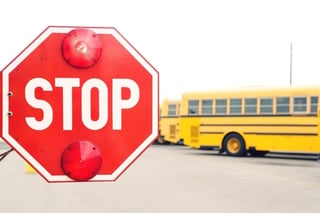New York May Levy Steeper Stop-Arm Fines - But Is That The Right Approach?
published on April 13, 2018 by Sonia Mastros
school bus safety, Student School Bus Safety, Stop-Arm Fines
 When drivers endanger school bus riders thousands of times every day by ignoring stop-arm signals, it’s clearly a problem that needs solving. But how?
When drivers endanger school bus riders thousands of times every day by ignoring stop-arm signals, it’s clearly a problem that needs solving. But how?
One of the more common solutions being adopted is the use of stop-arm cameras, which work in roughly the same fashion as traffic light cameras. The camera attempts to capture the license plate of anyone speeding by a stopped bus, and the resulting stop-arm fines are mailed to the offending driver’s address on record.
Recently, New York governor Andrew Cuomo, citing poor results from the state’s stop-arm program, announced his intention to push for even stricter stop-arm fines and other penalties. But is this really the right approach? Or does it signal that other measures are needed instead?
Are Stop-Arm Fines the Solution to Stop-Arm Violations?
Currently, New York already has among the toughest stop-arm violation penalties in the country: A first offense can bring up to 30 days in jail, a fine of up to $400, and a five-point penalty to the driver’s license. That’s well beyond most districts’ fine-only ticketing policy. Various proposals for increasing the penalties have been suggested, such as one proposed house bill that would push fees up to a maximum of $1,500 along with bringing the possibility of license suspensions for repeat offenses.
But would that actually reduce violations? Or would it merely lead to the state viewing stop-arm violations as a source of revenue?
Crime statistics showing that increased deterrents are genuinely successful at preventing crime are remarkably difficult to come by. Even the National Institute of Justice, a research arm of the U.S. Department of Justice, concludes, “increasing the severity of punishment does little to deter crime . .. partly because criminals know little about the sanctions for specific crimes.”
Further, studies into the effectiveness of stop-arm cameras have been inclusive. A 2008 Texas pilot program found their cameras had difficulty accurately capturing drivers’ license plates. North Carolina has been running a similar program for years, but their results don't seem to suggest an actual reduction in violations either.
Is There an Easier Way?
Meanwhile, a more low-key approach is being adopted by other districts, and with surprising success. By doing nothing more than adding more red lights to buses, violations were empirically reduced by 50% or more.
And it’s a cheap fix, too. The extra lights and wiring only sets districts back $200-$300 per bus.
The debate about deterrence-vs.-punishment has been ongoing for a long time, but when it comes to stop-arm fines, it doesn’t seem like the numbers are in favor of costlier punishment.
What do you think? Is it better to add stop-arm cameras, or more lights to ensure student and school bus safety? Let’s talk about it.



